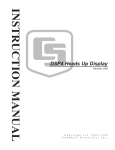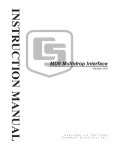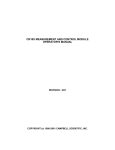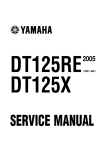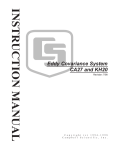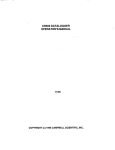Download Campbell SDS-122 Specifications
Transcript
SDS-122 Serial Data Switch 5/99 C o p y r i g h t © 1 9 9 6 - 1 9 9 9 C a m p b e l l S c i e n t i f i c , I n c . Warranty and Assistance The SDS-122 SERIAL DATA SWITCH is warranted by CAMPBELL SCIENTIFIC, INC. to be free from defects in materials and workmanship under normal use and service for twelve (12) months from date of shipment unless specified otherwise. Batteries have no warranty. CAMPBELL SCIENTIFIC, INC.'s obligation under this warranty is limited to repairing or replacing (at CAMPBELL SCIENTIFIC, INC.'s option) defective products. The customer shall assume all costs of removing, reinstalling, and shipping defective products to CAMPBELL SCIENTIFIC, INC. CAMPBELL SCIENTIFIC, INC. will return such products by surface carrier prepaid. This warranty shall not apply to any CAMPBELL SCIENTIFIC, INC. products which have been subjected to modification, misuse, neglect, accidents of nature, or shipping damage. This warranty is in lieu of all other warranties, expressed or implied, including warranties of merchantability or fitness for a particular purpose. CAMPBELL SCIENTIFIC, INC. is not liable for special, indirect, incidental, or consequential damages. Products may not be returned without prior authorization. The following contact information is for US and International customers residing in countries served by Campbell Scientific, Inc. directly. Affiliate companies handle repairs for customers within their territories. Please visit www.campbellsci.com to determine which Campbell Scientific company serves your country. To obtain a Returned Materials Authorization (RMA), contact CAMPBELL SCIENTIFIC, INC., phone (435) 753-2342. After an applications engineer determines the nature of the problem, an RMA number will be issued. Please write this number clearly on the outside of the shipping container. CAMPBELL SCIENTIFIC's shipping address is: CAMPBELL SCIENTIFIC, INC. RMA#_____ 815 West 1800 North Logan, Utah 84321-1784 CAMPBELL SCIENTIFIC, INC. does not accept collect calls. SDS-122 SERIAL DATA SWITCH TABLE OF CONTENTS PDF viewers note: These page numbers refer to the printed version of this document. Use the Adobe Acrobat® bookmarks tab for links to specific sections. 1. INTRODUCTION.........................................................................................................................1 2. SPECIFICATIONS .....................................................................................................................1 2.1 2.2 2.3 Physical......................................................................................................................................1 Operational.................................................................................................................................2 Port Configuration/Connections.................................................................................................2 3. INSTALLATION ..............................................................................................................................4 4. CONFIGURATION .........................................................................................................................4 4.1 4.2 4.3 Jumper Configuration.................................................................................................................5 Special Modes of Operation ......................................................................................................5 Default Jumper Settings.............................................................................................................8 LIST OF FIGURES 1. 2. 3. 4. 5. 6. General View of SDS-122 .....................................................................................................................1 Pin Positions for Datalogger Port: 9-way Male ‘D’ Type Connector .....................................................2 Pin Positions for Switched Datalogger Port ‘B’: 9-way Female ‘D’ Type Connector ............................3 Pin Positions for Switched RS232 Port ‘A’: 25-way Female ‘D’ Type Connector ..............................3 Default Jumper Positions on Circuit Board ...........................................................................................6 SDS-122 Settings for COM200 and SRM-6A (RAD Short Haul Modem).............................................7 LIST OF TABLES 1. Current Consumption in Various Modes/Communication Activity ........................................................2 This is a blank page. SDS-122 SERIAL DATA SWITCH The SDS-122 is a configurable two-way serial data switch which will allow two modem devices to be connected to a datalogger simultaneously, so allowing both remote and local interrogation of the datalogger to be carried out. It can support both DTE and DCE devices without the need for a null modem cable, and can operate either in manual or automatic mode. 1. INTRODUCTION The SDS-122 will normally be fitted in a datalogger enclosure. It allows two modems to be connected to a single datalogger at the same time and can automatically switch the datalogger to communicate with whichever modem initiates communications. The SDS-122 can support both DTE and DCE devices without the need for a null modem cable, and can emulate an SC932 (9-pin to RS232-DCE) interface. One port of the SDS122 can also be configured to emulate an optically isolated SC32A interface in either DCE or DTE mode. A jumper switch is provided for use with CR10/10X dataloggers to block the transmission of synchronous data. The SDS-122 can be set either for fully automatic mode, or manual mode, controlled by a datalogger control port or any logic signal. When in automatic mode, the SDS122 can be configured to either hold the last port rung or to default to a specific port, when communication finishes on either port. 2. SPECIFICATIONS 2.1 PHYSICAL Length (over mounting lugs): 195mm Width (over connectors): 75mm Height: 22mm Mounting Holes: 4.8mm dia. (0.1875in) at 177.8mm (7in) spacing(suitable for mounting onto an ENC 12/14 enclosure chassis plate) Weight: 180g FIGURE 1. General View of SDS-122 1 SDS-122 SERIAL DATA SWITCH 2.2 OPERATIONAL TABLE 1. Current Consumption in Various Modes/Communication Activity Mode Activity Current Drain from Datalogger Isolated Quiescent (not communicating) <75µA Isolated Communicating Up to 3mA Non-Isolated No RAD-SRM modem connected and with no communication activity (quiescent) <100µA Non-Isolated RAD-SRM connected, waiting for call 2.5mA Non-Isolated RAD-SRM in comms. session but no communication activity 9Ma Non-Isolated RAD-SRM communicating with PC208E or TCOM in Monitor Mode 12mA Non-Isolated Jumper PL50 not fitted; RAD-SRM connected but no communication activity. (This is the one-way, printenabled RAD-SRM mode.) <100µA Normal Operating Temperature Range: -25°C to +50°C For extended temperature range requirements please contact Campbell Scientific. 2.3 PORT CONFIGURATION/CONNECTIONS The SDS-122 has one datalogger port, one switched datalogger port, a 25-way switched RS232 port and a control port. Datalogger Port 1 2 6 3 7 4 8 5 9 FIGURE 2. Pin Positions for Datalogger Port: 9-way Male ‘D’ Type Connector The datalogger port (marked ‘LOGGER’ in Figure 1) is a 9-way male ‘D’ type connector, having the following pin configuration: 2 PIN ABBREVIATION I/O 1 2 3 4 5 6 7 8 9 +5V 0V RING RX ME SDE/PE CLK/HS Not connected TX O O I I I I NOTE: When the datalogger is in communication mode, pin 5 (ME – Modem Enable) is held high. This line is used by the SDS-122 to detect communications and prevent switching to the other port. SDS-122 SERIAL DATA SWITCH The switched datalogger port (marked ‘PORT B’ in Figure 1) is a 9-way female ‘D’ type connector, having the following pin configuration: Switched Datalogger Port B 5 4 9 3 8 2 7 1 6 FIGURE 3. Pin Positions for Switched Datalogger Port ‘B’: 9-way Female ‘D’ Type Connector PIN ABBREVIATION I/O 1 2 3 4 5 6 7 8 9 +5V 0V RING RX ME SDE/PE CLK/HS Not connected TX I I O O O O 25-Way Switched RS232 Port A SERIAL I/O 13 1 25 14 FIGURE 4. Pin Positions for Switched RS232 Port ‘A’: 25-way Female ‘D’ Type Connector The 25-way switched RS232 port (marked ‘RS232 PORT A’ in Figure 1) is a 25-way female ‘D’ type connector, having the following pin configuration: PIN ABBREVIATION 1 2 3 4 5 6 7 15 20 Frame Ground TX RX RTS CTS DSR GND External Power Supply DTR INPUT/OUTPUT DTE DCE O I O I I I O I O O I O I I Other pins are not connected. 3 SDS-122 SERIAL DATA SWITCH Control Port (3-way Screw Terminal) The control port is a 3-way terminal block with screwed connections. This terminal block can be unplugged from the unit for ease of wiring. The terminal connections are marked G, P and M and are used as follows: TERMINAL CONNECTION G 0V – It is recommended that a wire is run from this terminal to the main protective earth point in the system to give maximum protection from interference and transients. P In MANUAL mode, this terminal can be pulled high to select port B. In AUTO mode, when PL41 is fitted, it functions as an output and will go logic high when port B is being used or logic low when port A is being used. M wire is connected between the ‘G’ terminal of the SDS-122 and the system protective ground, to ensure optimum internal transient protection of the device. CAUTION: Although the SDS-122 has built-in transient protection, it is not protected against secondary lightning damage. Devices that are connected to port A or port B which are likely to be subject to large transients should have external protection fitted. For long cable runs on port A, RAD-SRM Short Haul modems fitted with RAD-SP lightning arrestors should be used. 4. CONFIGURATION The configuration of the SDS-122 is defined by internal jumpers. To access these jumpers it is necessary to open the case by removing the four case screws and pulling the two halves of the case apart. When this line is pulled high, the SDS-122 will be in MANUAL mode and only the port that is selected by the user (by using the P terminal) will be active. CAUTION: Before touching any components or jumpers, take precautions against electrostatic damage when handling the exposed circuit board – either by using an ESD protection earth strap connected to the sensor case, or, at the very least, by making sure that you discharge any static by touching the case or metal shell of the 'D' type connectors on the circuit board. 3. INSTALLATION You should install the SDS-122 in a dry, noncondensing environment. The ENC12/14 datalogger enclosure, available from Campbell Scientific, provides an ideal environment for both a CR10/10X datalogger and the SDS-122, plus a power supply or other equipment. Use one SC12 cable to connect the SDS122’s ‘datalogger’ port to a datalogger port, and a second to connect port ‘B’ to a compatible modem. A computer/short haul modem can be connected to port ‘A’ using a standard RS232 cable. Normally, for most applications, there will be no need for a connection to be made between the 3-way terminal block on the SDS-122 and the datalogger, unless direct measurements of the switch status, or manual control is required. It is recommended that a ground 4 The jumpers control: • The way in which the SDS-122 switches from one port to another • The RS232 port configuration (DCE or DTE) • The degree of isolation between the datalogger and the RS232 device. It is important to understand the different methods of isolation, as this can affect the accuracy of measurements made by the datalogger. In permanent installations it is good practice to ensure that the datalogger ground and computer ground are isolated, otherwise ground loops and digital noise could SDS-122 SERIAL DATA SWITCH result in errors on low-level analogue measurements. The SDS-122 can be set to provide opto-isolation to prevent such ground loops, but this mode of operation is not suitable for all RS232 devices, either because the device needs to source power from the datalogger or because it is not able to provide power to the output electronics of the SDS122. power available. When this mode is enabled, no isolation is provided by the SDS-122. Some devices, such as the RAD-SRM short haul modem, and most telephone modems provide their own isolation barrier. Care should be taken when selecting third party devices to ensure that they provide some form of barrier to prevent ground loops. 4.1 JUMPER CONFIGURATION WARNING: The opto-isolation provided by the SDS-122 is not designed, nor should it be used, for the purpose of providing a safety protection barrier. Internal protection devices will cause a breakdown of the isolation if the potential difference between the datalogger and RS232 ground exceeds 47V. To work in isolated mode, the RS232 device must provide power to the SDS-122 by holding at least one of the input handshaking lines at a positive voltage during communications (pins 4 or 20 in DCE mode, pins 5 or 6 in DTE mode). The voltage input to these lines must be <9V or be current limited to an effective source impedance of 1Kohm. If a suitable handshaking line is not available, a power source (6-20V) can be connected to pin 15 (referenced to pin 7G). In non-isolated mode, the SDS-122 can provide power from the datalogger via the handshaking lines, to power external interfaces. See details on jumpers PL50, PL51 and PL56 below for information on the It is envisaged that most applications will be with a telephone modem connected to Port B and a personal computer connected directly to Port A. The SDS-122, as supplied, has its jumpers set to this default configuration. The locations of the jumpers on the SDS-122 circuit board are shown in Figure 5. The description of each jumper and its default setting is given in Section 4.3. Note that some jumpers work in combination to achieve the state required. 4.2 SPECIAL MODES OF OPERATION The SDS-122 contains a programmable chip, which, in conjunction with the jumper settings (see Section 4) determines the way in which the ports are selected. Currently, the program allows one or other of the two communication ports to be connected to the datalogger. There is no state where neither port is connected. For special applications, the program can be modified to provide other modes of operation. Please contact Campbell Scientific for more details. 5 SDS-122 SERIAL DATA SWITCH OPEN OPEN OPEN OPEN C109 R44 PL41 PL42 PL43 PL44 R123 R147 R124 R122 R121 U1 R142 R47 D24 R14 CONN1 R130 U6 IC1 R150 D8 C108 UB1 R43 R149 C101 R126 U8 R141 R117 R118 CONN3 R120 R119 U7 R151 D21 U4 R16 R17 D22 C110 PL56 OPEN R145 R18 D17 R7 R13 U2 2 D16 3 D23 5 6 R148 1 7 R144 10 SW6-10 DCE D10 ISOLATED R8 C3 D15 DTE SW1-5 D20 CLOSED 8 9 4 PL50 Q6 PL51 OPEN POWERED D19 D18 C111 D4 C5 R20 Q3 C112 C7 FS1 ZD1 CONN2 U5 C6 R15 R9 U3 Q5 R31 C107 R36 R38 C113 CSL20026 CONN4 R46 R39 ISS 1 C106 FIGURE 5. Default Jumper Positions on Circuit Board 6 SDS-122 SERIAL DATA SWITCH OPEN OPEN OPEN OPEN C109 R44 PL41 PL42 PL43 PL44 R123 R147 R124 R122 R121 U1 R142 R47 D24 R14 CONN1 R130 U6 IC1 R150 D8 C108 UB1 R43 R149 C101 R126 U8 R141 R117 R118 CONN3 R120 R119 U7 R151 D21 U4 R16 R17 D22 C110 PL56 OPEN R145 R18 D17 R7 R13 U2 D15 DCE D10 SW6-10 D23 6 R148 7 R144 10 PL50 Q6 9 PL51 OPEN POWERED 5 1 4 DTE SW1-5 D20 CLOSED 8 3 DTE CHANGE TO POWER TURN 180” R8 ISOLATED 2 CHANGE TO C3 TURN 180” D16 D19 D18 C111 D4 C5 R20 Q3 C112 C7 FS1 ZD1 CONN2 U5 C6 R15 R9 U3 Q5 R31 C107 R36 R38 C113 CSL20026 CONN4 R46 R39 ISS 1 C106 FIGURE 6. SDS-122 Settings for COM200 and SRM-6A (RAD Short Haul Modem) 7 SDS-122 SERIAL DATA SWITCH 4.3 DEFAULT JUMPER SETTINGS JUMPER DEFAULT DESCRIPTION PL41 Not fitted When jumper PL41 is fitted, port A/B on the 3-way screw terminal will output 0V for switch on port A, or 5V for switch on port B when the SDS-122 is in AUTO mode only. When the jumper is not fitted, or the unit is in MANUAL mode, then the line becomes an input. PL42 Not fitted When jumper PL42 is fitted the SDS-122 will default to the port selected by PL43 when the ME line goes low. When the jumper is not fitted, the unit will stay with the last port used after the ME line goes low. PL43 Not fitted This jumper works in combination with jumper PL42. When jumper PL43 is fitted and jumper PL42 is also fitted, the SDS-122 will revert to port B when the ME line goes low. When PL43 is not fitted, but PL42 is fitted, the unit will default to port A when the ME line goes low. PL44 Not fitted When jumper PL44 is fitted and synchronous data is transmitted, (e.g. to a storage module), the SDS-122 will block any data output to port A. When PL44 is not fitted all data is allowed to pass through to port A. SW1-5 DCE Jumper block SW1-5 can be set so that port A can emulate either a DCE or DTE interface, and so there is no requirement for a null modem cable. The ‘DCE’ and ‘DTE’ jumper positions are marked on the PCB. Note that, to change the settings, the whole jumper block is removed and re-inserted at 180°. The red line on the jumper block should be adjacent to the state (DCE or DTE) required. SW6-10 Isolated Jumper block 6-10 can be set so that port A is either optically isolated or powered. RAD- SRM short haul modems would be driven in the powered mode. ‘Isolated’ and ‘Powered’ positions are marked on the PCB. Note that, to change the settings, the whole jumper block is removed and re-inserted at 180°. The red line on the jumper block should be adjacent to the state (Isolated or Powered) required. PL50 Fitted When jumper PL50 is fitted, not less than 4.3V is supplied to pins 20 and 4 of port A in DTE mode and to pins 5 and 6 of port A in DCE mode. RAD-SRM modems in interactive communications would need the PL50 jumper to be fitted. The actual voltage supplied to the pins will depend on the setting of jumper PL51 (see below). When the jumper is not fitted, no voltage is supplied. This has no effect in isolated mode. PL51 Not fitted When jumper PL51 is fitted, >7V is permanently output to pins 20 and 4 of port A in DTE mode and to pins 5 and 6 of port A in DCE mode. This jumper is not normally fitted for RAD-SRM modems in interactive communication. When not fitted the outputs are shut off when ME goes low. PL56 Not fitted When jumper PL56 is fitted, >7V is supplied to the handshake lines (pins 20 and 4 of port A in DTE mode and pins 5 and 6 of port A in DCE mode) when either ME or SDE/PE goes high. When jumper PL56 is not fitted, 7V will only be applied when ME is high. This has no effect in isolated mode. 8 This is a blank page. Campbell Scientific Companies Campbell Scientific, Inc. (CSI) 815 West 1800 North Logan, Utah 84321 UNITED STATES www.campbellsci.com [email protected] Campbell Scientific Africa Pty. Ltd. (CSAf) PO Box 2450 Somerset West 7129 SOUTH AFRICA www.csafrica.co.za [email protected] Campbell Scientific Australia Pty. Ltd. (CSA) PO Box 444 Thuringowa Central QLD 4812 AUSTRALIA www.campbellsci.com.au [email protected] Campbell Scientific do Brazil Ltda. (CSB) Rua Luisa Crapsi Orsi, 15 Butantã CEP: 005543-000 São Paulo SP BRAZIL www.campbellsci.com.br [email protected] Campbell Scientific Canada Corp. (CSC) 11564 - 149th Street NW Edmonton, Alberta T5M 1W7 CANADA www.campbellsci.ca [email protected] Campbell Scientific Ltd. (CSL) Campbell Park 80 Hathern Road Shepshed, Loughborough LE12 9GX UNITED KINGDOM www.campbellsci.co.uk [email protected] Campbell Scientific Ltd. (France) Miniparc du Verger - Bat. H 1, rue de Terre Neuve - Les Ulis 91967 COURTABOEUF CEDEX FRANCE www.campbellsci.fr [email protected] Campbell Scientific Spain, S. L. Psg. Font 14, local 8 08013 Barcelona SPAIN www.campbellsci.es [email protected] Please visit www.campbellsci.com to obtain contact information for your local US or International representative.














